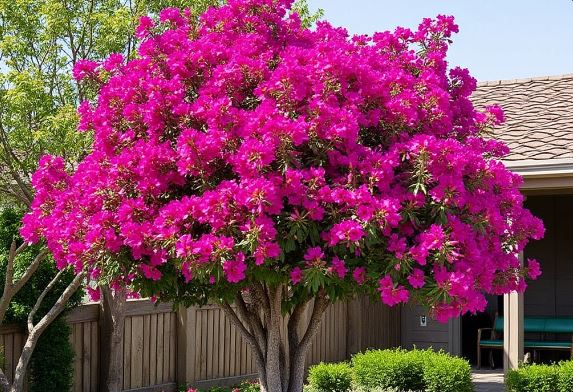
Bougainvillea glabra, commonly known as “Paper Flower,” is a highly popular species within the Bougainvillea genus. It is characterised by sleek, slender appearance and delicate bracts. Unlike Bougainvillea spectabilis, it tends to have a more compact growth habit and smaller bracts. It also has fewer thorns or may be thornless. The bracts are generally smaller than those of Bougainvillea spectabilis and come in a wider range of colors, including pink, white, orange, and even purple.
Characteristics
Bracts and Flowers
- Bracts: Bougainvillea glabra is famous for its paper-thin bracts that come in a variety of colors, most commonly in shades of purple, pink, magenta, or violet. These bracts surround the actual flowers, which are small, white, and tubular, located in the center.
- Flowers: The actual flowers are much smaller and inconspicuous, typically white or cream, surrounded by the colorful bracts.
Foliage
Leaves: The leaves are dark green, glossy, and slightly smaller and more slender than other Bougainvillea species. They are ovate to lanceolate in shape.
Growth Habit
- Vining nature: Bougainvillea glabra is a fast-growing climber that can grow up to 10-40 feet tall when trained on a trellis, wall, or arbor. It can also be pruned into a bush form if needed.
- Stems: The plant has thorny stems, which are characteristic of Bougainvillea and help support its climbing nature.
Blooming Season
- Flowering: Bougainvillea glabra tends to bloom almost year-round in tropical and subtropical climates, with a peak bloom in the summer and fall. It’s a heavy bloomer compared to other Bougainvillea species.
Hardiness
- Zones: It thrives in USDA zones 9-11 and can withstand some cold, but it is not frost-hardy. In cooler climates, it is grown as an annual or brought indoors during winter.
- Drought tolerance: Once established, it is highly drought-tolerant and performs well in dry, warm environments.
Cultivation
- Light: Full sun is essential for vibrant blooming. A minimum of 5-6 hours of direct sunlight is recommended.
- Soil: Prefers well-drained, somewhat sandy soil with a neutral to slightly acidic pH. Good drainage is critical as waterlogged soil can lead to root rot.
- Watering: Water thoroughly but allow the soil to dry out between waterings. B. glabra is quite drought-tolerant once established.
- Fertilization: Use a balanced fertilizer or one that encourages blooming (higher in phosphorus) during the growing season. However, too much nitrogen can lead to excessive leaf growth at the expense of flowers.
- Pruning: Can be pruned heavily after each bloom cycle to encourage new growth and more flowers. Pruning also helps in shaping the plant or controlling its size.
- Support: While it can grow unsupported as a bush, providing a trellis or other support allows it to climb and can help in managing its growth.
- Pests and Diseases: Generally hardy, but watch out for aphids, caterpillars, and occasionally scale. Root rot can be an issue in poorly drained soils.
- Cold Protection: In cooler climates, it’s best grown in pots to move indoors during winter, or provide protection with frost cloth or mulch to protect the roots from light freezes.
- Propagation: Can be propagated from semi-hardwood cuttings taken in summer. Rooting hormone can aid in propagation success.
Uses
- Landscaping: Bougainvillea glabra is perfect for covering walls, fences, trellises, and arbors due to its vining nature.
- Container gardening: It can be grown in containers in colder climates, making it easier to bring indoors during winter.
- Hedges and ground cover: When pruned, it can be used as a colorful hedge or ground cover.